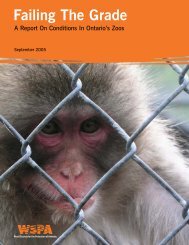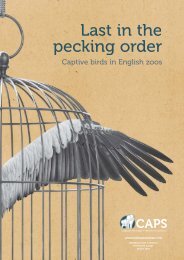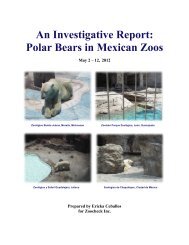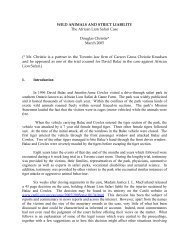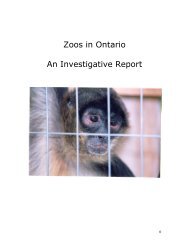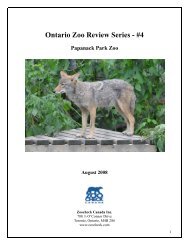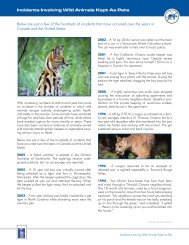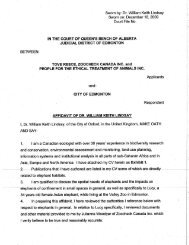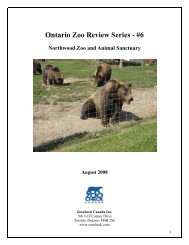STATUS OF BEAR WELFARE
STATUS OF BEAR WELFARE
STATUS OF BEAR WELFARE
Create successful ePaper yourself
Turn your PDF publications into a flip-book with our unique Google optimized e-Paper software.
Status of Bear Welfare in Cherokee, North Carolina<br />
normally dispersed social nature, they were put in a situation in which they competed for limited<br />
resources such as shade, dry areas, or preferred feeding areas where they could look for food<br />
from the public.<br />
Bears are not solitary animals, as previously thought. Bears are independent animals who are<br />
actually highly social in nature and live in what can be thought of as dispersed social groups,<br />
meaning that they are aware that they are sharing their habitat with other bears and leave<br />
information for other bears about food resources and their own movements on scratching trees,<br />
scent trails, etc. Female bears are genetically programmed to expect to live with other bears for<br />
the vast majority of their lives. Males are programmed to meet and greet other bears throughout<br />
the year, not just during breeding season.<br />
Bears in captivity must have adequate space and a proper enclosure design to allow them to<br />
escape competition and confrontation and be able to find privacy.<br />
Pits (Chief Saunooke Bear Park and Cherokee Bear Zoo)<br />
Although the bears in the pits at CSBP and CBZ were alive, their quality of life was grossly<br />
substandard. The design of the small, barren concrete pits was as old as ancient Rome and<br />
became very popular in North America in the 1930s, when very little was known about bears<br />
except that they were sometimes dangerous to humans. The pits were not built to accommodate<br />
the bears’ natural behavior—only to accommodate human safety and to provide human<br />
entertainment.<br />
The bears were essentially warehoused as exhibit pieces with no ability to engage in normal<br />
activity, no choice over their activities, and no control over what they could do. In other words,<br />
they could not make a meaningful contribution to the quality of their own lives.<br />
Sensory Deprivation<br />
Confinement in a pit means living in a sensory-deprived world with almost no visual stimulation,<br />
little olfactory stimulation, and limited auditory stimulation.<br />
Smell is a bear’s primary sense. The structure of the concrete pit did not allow wind to eddy into it<br />
bringing airborne information about the bear’s environment. Sight is a human’s primary sense.<br />
Depriving a bear of olfactory experiences is akin to blindfolding a human.<br />
Sensory deprivation is widely recognized as the deliberate reduction or removal of stimuli from<br />
one or more of the senses and can result in anxiety or depression in humans. Highly intelligent<br />
and sentient beings, whether humans, bears, or members of another species, can suffer greatly<br />
from loss of freedom, lack of sensory stimulation, lack of privacy, and close confinement.<br />
Excessive Noise<br />
The design of the pits coupled with the lack of natural elements left these bears surrounded by<br />
acoustically reflective surfaces and subjected them to a constant din caused by people shouting,<br />
children squealing, water pumps turning on and off, and traffic noise. Although this is more likely<br />
to disturb younger bears than those who are chronically exposed to noise, it is still an unnatural<br />
assault on their auditory systems.<br />
AN INVESTIGATIVE REPORT <strong>OF</strong> CHIEF SAUNOOKE <strong>BEAR</strong> PARK, CHEROKEE <strong>BEAR</strong> ZOO, AND SANTA’S LAND | 18





